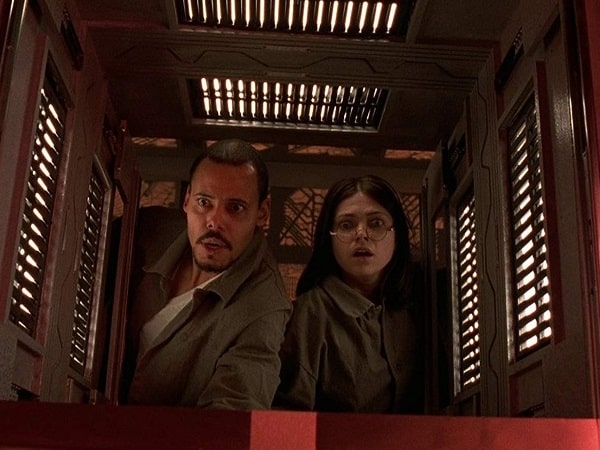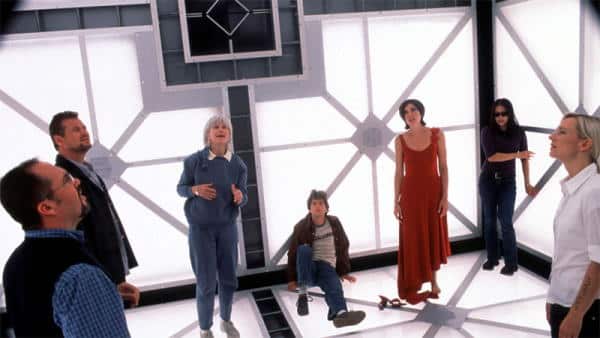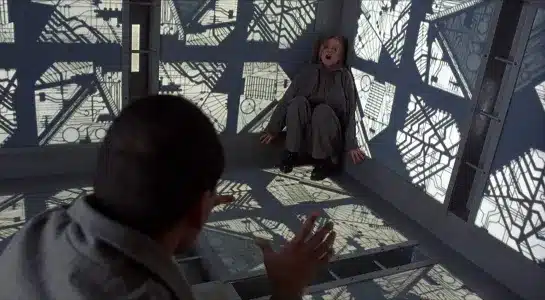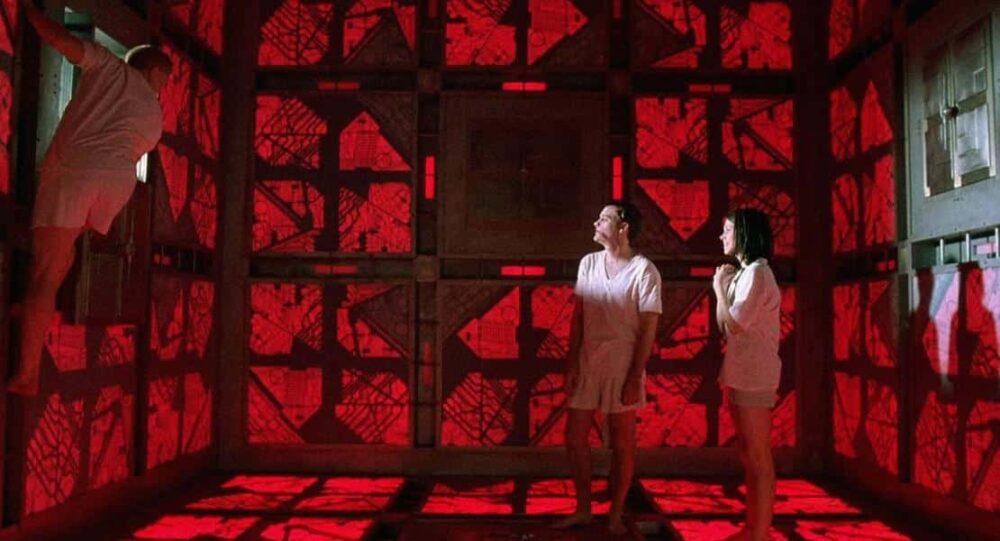One simply cannot avoid bringing up the sci-fi thriller Cube while discussing innovative horror films with an original idea and a poor run of sequels. In this scenario, a group of people suddenly find themselves in a hostile environment and must use all the knowledge and tools at their disposal to find a way out. Although it is sometimes compa
red to Saw, the similarities are only superficial and more aesthetically oriented. The main themes of Saw are retribution and redemption.In Cube, the focus is on the social experiment that is being conducted. Without further ado, let’s examine what Cube is about and why it is a masterclass in narrative structure. Spoilers follow as the Cube movie’s narrative and conclusion are explained.
Cube Movie| A Brief Synopsis of the Plot
A group of survivors awaken in a maze made up of 14-by-14-foot rooms that are cube-shaped. The rooms are identified by numbers, and some of them contain lethal traps. The inmates are unaware that the cubical room is a maze and have no idea how or why they ended themselves there.
The group makes an effort to find solutions while formulating ideas as to why and where they are. Except for Worth, who helped build the Cube’s outer shell but didn’t know more than what was required of him, everyone else appears to have been chosen sporadically.

The fact that they are chosen based on their archetypes, personalities, and skills is one thing that is undeniably true, and this clearly suggests that some sort of perverse experiment, like in the film Circle, is genuinely taking place.
They are certain to learn swiftly and nimbly since they are put to the test in a real-world setting. Additionally, they should exert every last bit of their potential in this effort. It’s related to the idea that a student will never advance as quickly in a typical school environment as they can with a deftly designed community engagement programme. Simply put, learning and witnessing an example are more effective.
The gang quickly begins to turn on one another, and in the end, the only survivor who is able to escape is a member of the group who has a mental disability.
Explained ending of the Cube movie
The conclusion of the film Cube illustrates how everyone would have been safe and undamaged had the gang done nothing and waited for too long. The initial Cube travelled between the inside and exterior regions of the maze.
But that’s not how people are made. When a challenge arises, we must find a solution. If you give it some thought, human intelligence may occasionally be seen as the curse that pushes us—as a species—closer to extinction.

Movie Cube| Characters
Regardless of your opinion of the tale as a whole, the storytelling is excellent. It’s as if someone took great care not to overlook a simple detail while reading a very detailed book outlining all the dos and don’ts of narration, character development, and story progression.
Names of Characters in Cube
First of all, each character’s name begins with a unique letter. Quentin, Leaven, Holloway, Rennes, Worth, and Kazan are the individuals we have (K). With so many names that sound alike (we’re looking at you, GRR Martin), it is simple to avoid confounding the audience in this way.
In addition, the names of the characters allude to notable jails, suggesting that their captivity in the Cube may have been preplanned. This more or less confirms Quentin’s belief that it was all planned for someone’s evil amusement. San Quentin inspired the naming of Quentin. Together, Leaven and Worth stand for Leavenworth. While Rennes and Kazan are the locations of notorious prisons in France and Russia, respectively, Holloway is named after a well-known women’s jail in the United Kingdom.
The Development of Character
The character revelation heavily relies on their hypotheses regarding the Cube’s function. For instance, Holloway jumps to the conclusion that it’s a government plot, whereas Quentin immediately surmises that a magnate’s sociopathic fantasies are at work. Worth’s belief that everything is just chaotic and ungoverned reveals his pessimistic attitude on existence (perhaps even ungovernable).

Additionally, it demonstrates how various characters change while under stress. For instance, Quentin first comes across as the most courageous person, but he quickly gives in to fear and paranoia. A person who at first glance appeared to be a natural leader ultimately proves to be a burden. Ironically, Kazan, who at first appeared to be a burden, ended up being their best chance of escape.
This is the author’s interpretation of the fight, flight, or freeze reaction in urgent circumstances. For instance, Worth is a nihilist. But when pressured, he transforms into a guardian and a survivor (even though it takes him a bit to develop in this direction).
Each character serves as an archetype, and there are just the right number of characters for the plot to function. The minimal amount of bloodshed and gore is all for narrative purposes.
Alderson’s death in the beginning serves as a perfect example of “show, don’t tell,” informing us that the environment is in fact harmful. For two reasons, Rennes is murdered so quickly. First, explain why he is best equipped to handle the current issue in order to prevent the group from using him as a crutch. Leaven might have remained silent for the remainder of the film if Rennes had not been killed. Second, it demonstrates that escaping the Cube is not guaranteed by skill or survivability alone.
Movie Cube| Narration
War’s Fog
The storytelling is so brilliant that it traps the listener inside the Cube as well. You are unaware of which room is compromised (same as them). We are relying on Leaven to explain it to us since, like Quentin, Holloway, and Worth, the average spectator doesn’t comprehend the X, Y, and Z coordination or the derived equations. As a result, we are in the same situation as the other characters. At the same moment as they do, we determine whether the room is a trap.
Internal Coherence of Logic
When applying Occam’s Razor, the placement of the “bridge” (exit) is also pretty rational (a principle that claims that the most obvious solution is often the most logical). Why did they begin by the door? From a logistical perspective, you can see that someone had to transport them into the maze or cube (an employee working behind the scenes managing it). The protagonists shouldn’t have to be carried particularly far into the cube if the chambers can move about on their own. They could have simply been left near the entrance, where they would have dispersed as the cube moved deeper and deeper (which is exactly what happened).

As They Learn, So Do We
Most crucially, the characters are flawed, and as the story goes on, so is the audience’s understanding of the Cube’s nature. At first, they err by drawing conclusions from inaccurate presumptions and insufficient data.
The movie’s true antagonist is Cube.
The Cube movie’s message is also highly potent and is conveyed to the audience gently. You’ll come to the conclusion that Quentin killed more people than the Cube once you start doing the arithmetic. Rennes and Alderson were killed by The Cube, while Quentin killed Leaven, Holloway, and Worth before being killed by Worth. In other words, no matter how hostile the environment, social organisations are frequently most at risk from their own members. No matter how harsh the environment may be, one may adapt to it.
Cube Movie| Final Verdict
In the end, this film leaves the viewer with more questions than it answers. Who designed the Cube? Why did it get made? But this was never the main point. First of all, neither the convicts nor you will ever find all the answers you seek in life. Second, the experiment itself offers a greater understanding of human nature, and the tone throughout the film is one of uncertainty and fear. It seems as though the audience is also confined to the cube with the characters.
ALSO READ THIS: 13 Sins 2014 Film Explained
